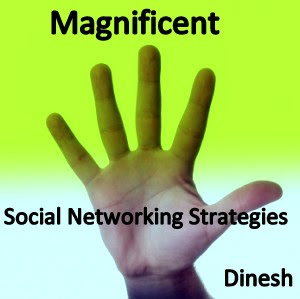 Magnificent 5 Social Networking Strategies for your Company
Magnificent 5 Social Networking Strategies for your CompanyDears,
Magnificent 5 Social Networking Strategies for your Company
If you’re reading this blog, chances are you have an account with either Facebook, LinkedIn, Twitter—if not all of them. It’s almost certain that you have watched a video on YouTube or looked at pictures on Flickr. You might even be a blogger yourself. But social networking for purely social and personal purposes is different than using a social networking strategy to grow your business.
If you’re reading this blog, chances are you have an account with either Facebook, LinkedIn, Twitter—if not all of them. It’s almost certain that you have watched a video on YouTube or looked at pictures on Flickr. You might even be a blogger yourself. But social networking for purely social and personal purposes is different than using a social networking strategy to grow your business.
So your company has opened a Twitter account and uploaded its logo as an avatar. What now?
Here are five best practices that can help you be a smart social networker.
1) Decide What to Achieve Through Social Networking
Are you trying to raise awareness?
Is your goal to improve the company’s product through collaboration?
Just here to advertise the product?
Are you striving to improve customer service?
Using the tools for contests or campaigns to drive business to the company’s website?
Want to survey customers to gather information in a crowd sourcing forum?
Are you promoting an event to increase sales or raise funds?
Do you need a forum to facilitate a discussion?
Each answer to these questions will allow your business to determine which social networking tool is the best to achieve the desired goal. Blogs, Facebook, Twitter, YouTube and LinkedIn may each play a role, depending upon the desired outcome.
2) Decide Where to Apportion Your Attention and Energy
Depending upon the company’s goals, you will want to use various social networking tools in different capacities. For instance, many companies use Twitter for customer service applications. Some companies use blogs to provide value-added information and to engage customers in a less formal atmosphere, while still providing purchasing opportunities. Promoting your business through Foursquare, by offering a badge that user can achieve by “checking in” from your brick-and-mortar site or by offering freebies to Foursquare users, can really get your name out there and get people buzzing, especially since Foursquare is integrated with Twitter. Other businesses rely on Facebook to host contests, solicit feedback from users, and organize events related to their products.
Depending upon the company’s goals, you will want to use various social networking tools in different capacities. For instance, many companies use Twitter for customer service applications. Some companies use blogs to provide value-added information and to engage customers in a less formal atmosphere, while still providing purchasing opportunities. Promoting your business through Foursquare, by offering a badge that user can achieve by “checking in” from your brick-and-mortar site or by offering freebies to Foursquare users, can really get your name out there and get people buzzing, especially since Foursquare is integrated with Twitter. Other businesses rely on Facebook to host contests, solicit feedback from users, and organize events related to their products.
3) Monitor the Social Networking Sites
Once the company decides which social networking tools to use to accomplish the desired goal, the next step is to monitor the social networking site of choice, and to analyze the data once it is received. A cloud-based customer relationship management application can help your company do this with ease, by aggregating the information, presenting it in accessible formats such as charts or graphs, and making the result available to authorized users across all channels of your company. Yet you’ll also need to have a dedicated staff member who handles your social media, reading and sending tweets or updating Facebook statuses. Companies who monitor social networks through a combination of human interaction and automated CRM processes can alleviate customer concerns before they escalate, and use the knowledge they gain to drive marketing initiatives.
4) Implement the Idea or Strategy
Once companies gather information from various social networking sites, they must use the information to make a change or improvement in the product, service, or company. For instance, a company may engage an audience through YouTube. However, once the audience is engaged, the company needs to use the excitement to drive them to action, whether it is to buy a product or donate for a cause. Alternatively, if information is gathered through Twitter or a blog, companies must take action to implement the suggestions. It doesn’t do any good to have a social media component to your business if you don’t use it. These are excellent platforms for listening to your customers—takes what they say and apply it.
5) Follow Up
This might sound simplistic, but it’s surprising how many companies don’t follow up with their customers after responding to a concern or addressing a need using social media. Again, if you’re listening to your customers and responding to them through these channels, wouldn’t it be a good idea to go that extra mile and tell them thank you, or ask if the situation was resolved to their satisfaction? In the case of promotions, you’ll need to keep engaging the new fans or followers that you receive as a result of the campaign—follow up by asking for their feedback or opinions, offer them additional coupons or information, and generally keep your brand on the tip of their tongue, to transform them from a casual fan into a lifelong customer.
Happy Social Networking and Wishing you Great Funfilled Weekend
Your Partner and Companion
DC*

No comments:
Post a Comment